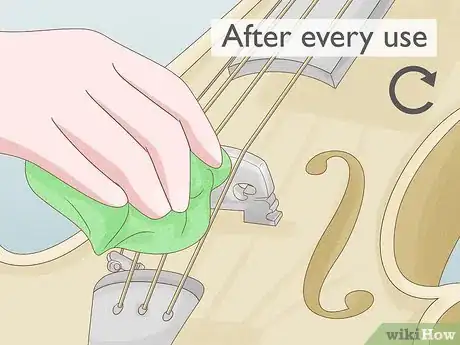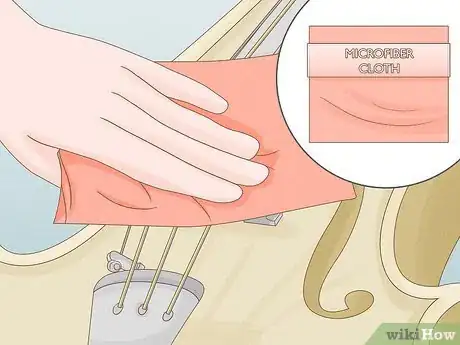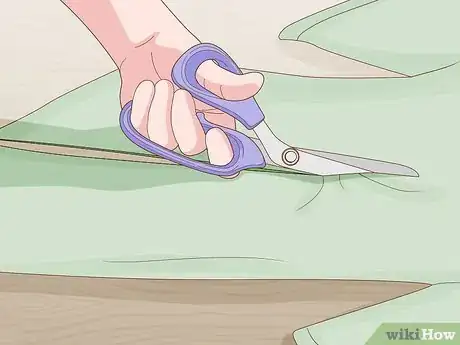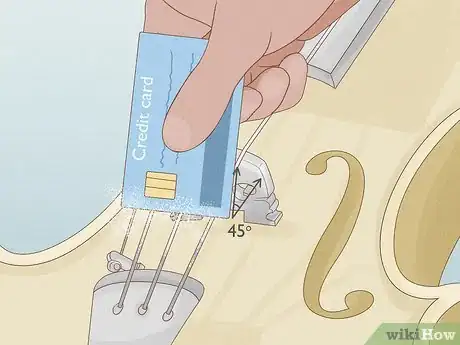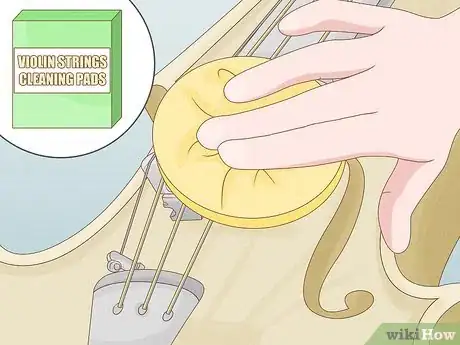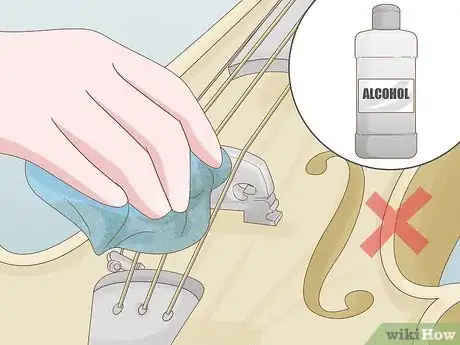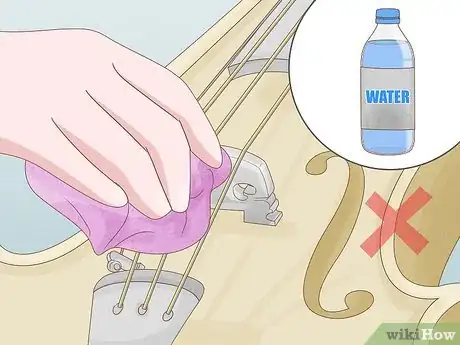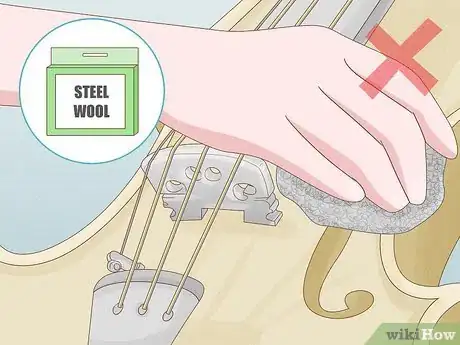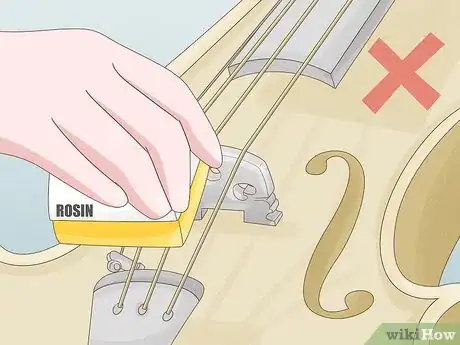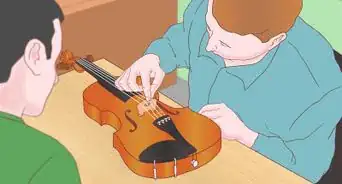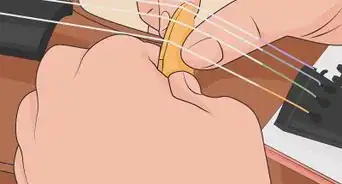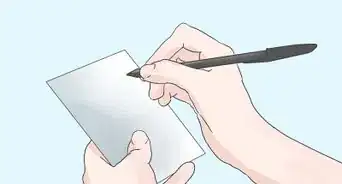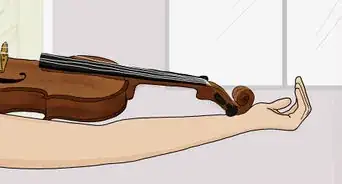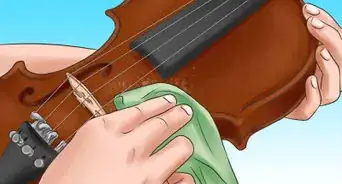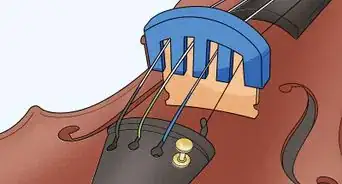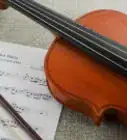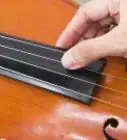This article was co-authored by wikiHow staff writer, Janice Tieperman. Janice is a professional and creative writer who has worked at wikiHow since 2019. With both a B.A. and M.A. in English from East Stroudsburg University, she has a passion for writing a wide variety of content for anyone and everyone. In her free time, you can find her working on a new crochet pattern, listening to true crime podcasts, or tackling a new creative writing project.
wikiHow marks an article as reader-approved once it receives enough positive feedback. In this case, 80% of readers who voted found the article helpful, earning it our reader-approved status.
This article has been viewed 55,502 times.
Learn more...
Your violin is pretty hardy, but your strings need some TLC to stay in tip-top condition throughout your practice sessions and performances. Thankfully, cleaning violin strings is not nearly as time-consuming as cleaning the entire violin. With regular maintenance, you can keep your strings free of rosin with the help of a few common household items.
Steps
Removing Rosin Buildup
-
1Clean your strings after every use so rosin doesn’t build up. Get in the habit of cleaning your violin strings every time you play, especially if you play your instrument often. Before putting the violin back in its case, wipe down the strings to clear away any rosin residue, so it doesn’t build up over time.[1]
- Rosin build-up makes your strings look white.
-
2Wipe down your strings with a microfiber cloth. Grab a soft, non-abrasive cloth that won’t damage your strings or fingerboards. Move the cloth along the entire length of the string, taking care to wipe beneath the string as well. Ultimately, you don’t want rosin to build up on your instrument, or else it may not sound as clear and professional as possible.[2]
- Clean or replace your microfiber cloth at least once a year, if you can.[3]
Advertisement -
3Cut up an old T-shirt if you don’t have a special cloth on hand. Grab a soft, old tee that you don’t use much anymore. Snip into small squares, which you can carry with you in your violin case. Like the microfiber cloth, wipe down the entire string to get rid of any leftover rosin residue.[4]
- Try to wash these squares at least once a year, especially if you play violin often.
- The squares don’t have to be a specific size—however, they should be large enough to comfortably hold and move over the strings.
-
4Clean off your strings with the side of a credit card in a pinch. Grab an old credit or debit card from your wallet and arrange it along the side of each string at a 45-degree angle. Move the card along the entire length of the string to get rid of a lot of rosin residue.[5]
- This isn’t as thorough as wiping off the string with a cloth, but it’s a good solution if you don’t have anything else on hand.
-
5Wipe down your strings with specialized cleaning pads. Look online for specialty products designed specifically for violins and other orchestra instruments. Just center and pinch the pad on top of each string, dragging it along the string to get rid of the resin residue.[6]
- It takes a few swipes to get rid of your leftover rosin.
- These pads are similar to steel wool, but aren’t as abrasive.
What to Avoid
-
1Refrain from using alcohol to clean your strings. Alcohol tends to be a popular suggestion online, but it isn’t very practical for the long-term health of your instrument. Alcohol and other liquid solvents can damage and shorten the lifespan of your strings. Stick to simpler cleaning methods instead, like wiping off your strings with a dry cloth.[7]
- If alcohol gets on your violin, it may damage the finish.[8]
-
2Don’t clean your violin strings with water. A water-soaked cloth will remove some of your rosin dust, but it won’t make a big dent in the problem. Instead, just clean off your instrument with a dry cloth instead.[9]
-
3Avoid cleaning your strings or fingerboard with steel wool. Steel wool is a popular solution for rosin residue. Unfortunately, steel wool microscopically damages and changes your strings, which will change the way your instrument sounds. This can make it harder to tune your instrument more accurately, and will do more long-term damage than good.[10]
- If you look at a zoomed-in picture of a violin string that was rubbed with steel wool compared to a normal string, you’ll see a noticeable difference.
-
4Don’t apply rosin to your violin strings. Rosin is designed specifically for violin bows—even if it seems convenient, you won’t be doing yourself any favors if you apply the product directly to your strings. Instead, reach for a safer alternative, like a clean piece of cloth.[11]
- While this probably isn’t the source of your rosin buildup, it’s still helpful to keep in mind as you play and clean your instrument.
Community Q&A
-
QuestionCan I just use a cloth for minor cleanings?
 Amanda EarnhartCommunity AnswerYes, you can. You could simply cut up an old T-shirt to use, but there are slightly higher quality cleaning cloths you can buy. Wiping the areas on your strings with the most rosin using a gentle but firm pressure is the best way to do it.
Amanda EarnhartCommunity AnswerYes, you can. You could simply cut up an old T-shirt to use, but there are slightly higher quality cleaning cloths you can buy. Wiping the areas on your strings with the most rosin using a gentle but firm pressure is the best way to do it. -
QuestionHow can I clean the excess rosin that fell on the body of my violin if I can't use alcohol?
 Community AnswerJust use a clean, dry microfiber cloth to wipe down your violin.
Community AnswerJust use a clean, dry microfiber cloth to wipe down your violin.
Things You’ll Need
- Microfiber cloth
- T-shirt (optional)
- Credit card (optional)
- Cleaning pads (optional)
References
- ↑ https://www.connollymusic.com/stringovation/how-to-care-for-your-violin-strings
- ↑ https://www.connollymusic.com/stringovation/how-to-care-for-your-violin-strings
- ↑ https://www.connollymusic.com/stringovation/how-to-care-for-your-violin-strings
- ↑ https://stringsmagazine.com/ask-the-expert-the-fine-balance-between-grime-shine/
- ↑ https://www.warchal.com/faq/what_is_the_best_way_to_care_for_our_strings.html
- ↑ https://www.violins.ca/info/how-to-clean-your-violin-strings-easily.html
- ↑ https://www.warchal.com/faq/what_is_the_best_way_to_care_for_our_strings.html
- ↑ https://www.connollymusic.com/stringovation/how-to-care-for-your-violin-strings
- ↑ https://www.violins.ca/info/how-to-clean-your-violin-strings-easily.html
About This Article
If you need to clean the strings on your violin, wet a soft, lint-free cloth with just enough rubbing alcohol so it’s damp but not dripping. Turn your violin upside-down, so the strings are facing the floor, then rub the damp cloth back and forth along the strings to clean them. If there’s a lot of resin build-up on the strings, you might need to rub a little harder in those spots. Do not let the alcohol touch the body or the back of the guitar, although it’s fine if it touches the fingerboard. Dry the strings with a clean cloth. For tips on using a spare rag to prevent resin build-up on your violin strings, read on!
